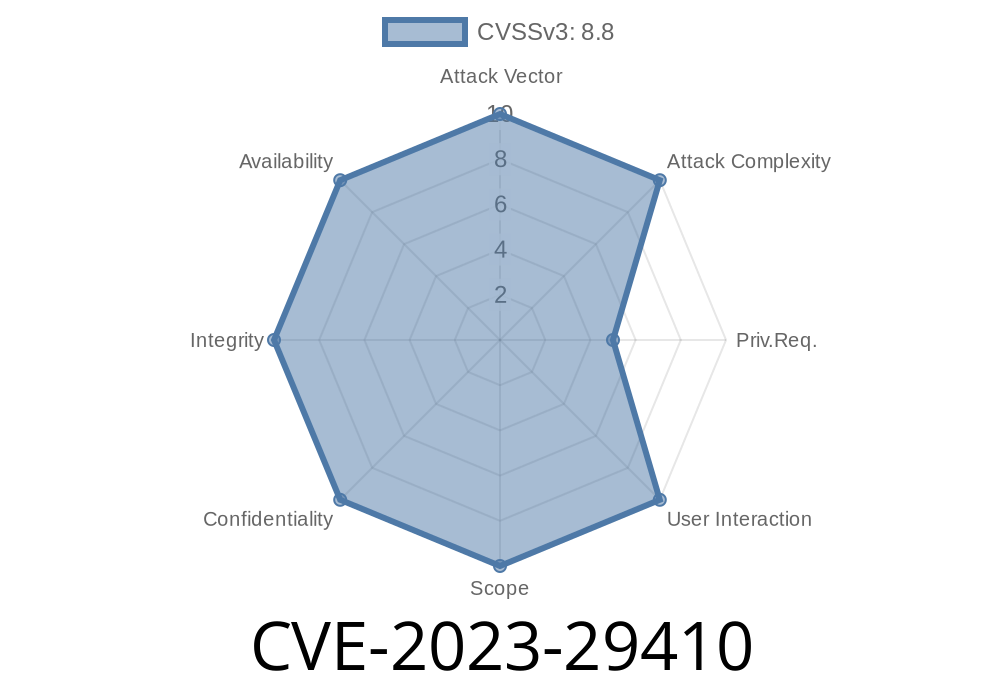Security researchers have recently identified a critical vulnerability, which has been registered as CVE-2023-29410, associated with CWE-20 (Improper Input Validation). This vulnerability allows authenticated threat actors to gain unauthorized privileges, potentially as high as the application's own privilege level, on the targeted server. This security flaw exposes web applications to severe risks if exploited, including unauthorized access, sensitive data leakage, and potentially causing severe disruption to their services.
In this article, we will dive into the details of CVE-2023-29410, learn about the related code snippet, discuss the implications, and point to some reliable sources for further information. By the end of the article, readers should be able to recognize the vulnerability, understand its implications, and find ways to address it.
CVE-2023-29410: Technical Overview
CVE-2023-29410 is a vulnerability related to CWE-20 (Improper Input Validation). It enables a threat actor, who is authenticated, to send a carefully crafted HTTP payload to the targeted server and force the server to execute it. As a result, the attacker could potentially gain privileges equal to the application on the server.
To exploit this vulnerability, an attacker needs to identify an input field within a web application where validation rules are inadequately implemented. For instance, they might bypass the validation procedures by sending a malicious payload, which might include malicious scripts or function calls through an HTTP request.
Sample Code Snippet
Suppose a web application relies on the following server-side code to validate and process user input:
def process_request(request):
data = request.data
if validate_input(data):
result = execute_task(data)
return result
else:
return "Invalid input"
def validate_input(data):
# Checks if input contains any invalid characters
for char in data:
if char in invalid_chars:
return False
return True
An attacker might craft a specially designed payload, such as
<script>alert("Attacker's token: " + document.cookie)</script>
And then send it as 'data' in an HTTP request. If the server does not validate the input properly and checks only for invalid characters rather than the presence of dangerous content, it may execute the attacker's malicious script.
For more information about CVE-2023-29410, we recommend visiting the following sources
1. Official CVE Details: The official entry on the MITRE CVE database provides a concise summary and references to external resources.
2. CWE-20: Improper Input Validation: The comprehensive description of the CWE entry related to this vulnerability, discussing its nature and potential consequences.
3. OWASP Top 10 Web Application Security Risks: The Open Web Application Security Project (OWASP) provides a list of the most critical security risks to web applications, including input validation.
The exploit details and mitigation steps for CVE-2023-29410 include
1. Proper Input Validation: Ensure that all input fields in the web application are subject to thorough validation, including checking data types, lengths, formats, and ranges. Employ secure coding practices and adhere to the OWASP Input Validation Cheat Sheet.
2. Input Sanitization: Employ input sanitization techniques such as output encoding, input escaping, and parameterization to neutralize the effect of potentially harmful data.
3. Principle of Least Privilege: Configure your server and web application to operate with the least necessary privileges, reducing the potential harm of a successful exploit.
4. Monitoring and Logging: Implement a robust monitoring and intrusion detection mechanism that can identify, flag, and block suspicious activity.
Conclusion
CVE-2023-29410 presents a severe risk to web applications that do not adequately validate input data and is related to CWE-20 (Improper Input Validation). To mitigate this risk, web application developers should employ effective input validation and sanitization techniques in conjunction with the principle of least privilege and robust monitoring. By raising awareness of this critical vulnerability and its potential consequences, we hope to empower developers and administrators to take proactive measures to safeguard their web applications and server environments against such attacks.
Timeline
Published on: 04/18/2023 22:15:00 UTC
Last modified on: 04/28/2023 01:25:00 UTC
